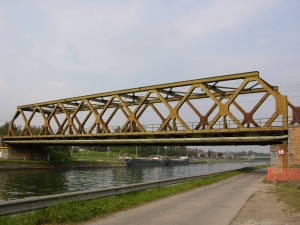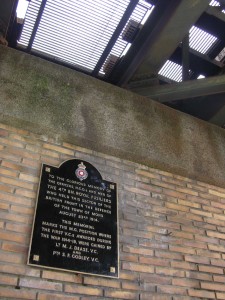
Nimy Railway Bridge, Belgium.
Snapshot of the Great War 23 August 1914
Once again looking back upon our day in the vicinity of Mons my friends and I took in the site where the first two Victoria Crosses of the Great War were earned. It was at Nimy Railway Bridge that Private Sidney Frank Godley and Lieutenant Maurice Dease of the 4th Battalion Royal Fusiliers manned a machine gun position after others in the battalion were killed or wounded. Dease was mortally wounded and when instructions were received to retreat Godley volunteered to hold the line until the battalion managed to remove itself from harm’s way (for the time being). Godley fought the fight alone for two hours under very heavy fire and was wounded twice, in the head and back. Despite the onslaught Godley, being out of ammunition, then dismantled the machine gun and threw the pieces into the canal below. Godley was made a prisoner of war. The Godley Victoria Cross is privately held.

Plaque at Nimy Railway Bridge commemorating the actions of Dease and Godley.
Dease who commanded the machine gun was wounded on five occasions during the desperate action. He is buried at St. Symphorien Military Cemetery, Belgium. His posthumous Victoria Cross is exhibited at the Tower of London in the Royal Fusiliers Museum.
In 1914 from August through December 46 awards of the Victoria Cross were earned including 8 awards to soldiers in Scottish regiments.
Tags: 23 August 1914, Machine Gun, Maurice Dease, Nimy Railway Bridge, Royal Fusiliers, Sidney Frank Godley, Victoria Cross
This entry was posted by pferguson
on Saturday, August 23rd, 2014 at 9:32 am and is filed under Snapshots of the Great War.
You can follow any responses to this entry through the RSS 2.0 feed.
You can leave a response, or trackback from your own site.
About The Author

Paul has worked with the Paradigm Motion Picture Company since 2009 as producer, historian and research specialist. Paul first met Casey and Ian WIlliams of Paradigm in April 2007 at Ieper (Ypres), Belgium when ceremonies were being held for the re-dedication of the Vimy Memorial, France.
Paul's sensitivity to film was developed at an early age seeing his first films at RCAF Zweibrucken, Germany and Sardinia. Paul returned to Canada in 1967 and was captivated by David Lean's "Lawrence of Arabia" and "Bridge on the River Kwai". Over time Paul became increasingly interested in storytelling, content development, character, direction, cinematography, narration and soundtracks.
At the University of Victoria, Paul studied and compared Japanese and Australian film and became interested in Australian film maker Peter Weir and his film "Gallipoli" (1981). Paul was inspired when he learned Weir visited the beaches, ridges and ravines of the peninsula. "Gallipoli", the film, led Paul on many journeys to sites of conflict in England, France, Belgium, Holland, Germany, Malta, Hawaii, Gallipoli, North Macedonia and Salonika.
When Paul first watched documentary filmmaker Ken Burns, "The Civil War", Paul understood how his own experience and insight could be effective and perhaps influential in film-making. Combining his knowledge of Museums and Archives, exhibitions and idea strategies with his film interests was a natural progression.
Paul thinks like a film-maker. His passion for history and storytelling brings to Paradigm an eye (and ear) to the keen and sensitive interests of; content development, the understanding of successful and relational use of collections, imagery and voice. Like Paul's favorite actor, Peter O'Toole, Paul believes in the adage “To deepen not broaden.”
While on this path Paul always remembers his grandmother whose father did not return from the Great War and how his loss shaped her life and how her experience continues to guide him.



Comments